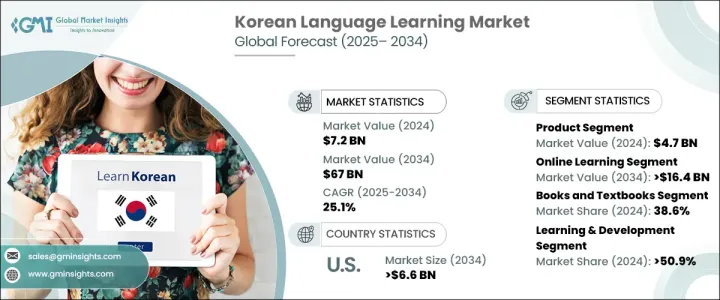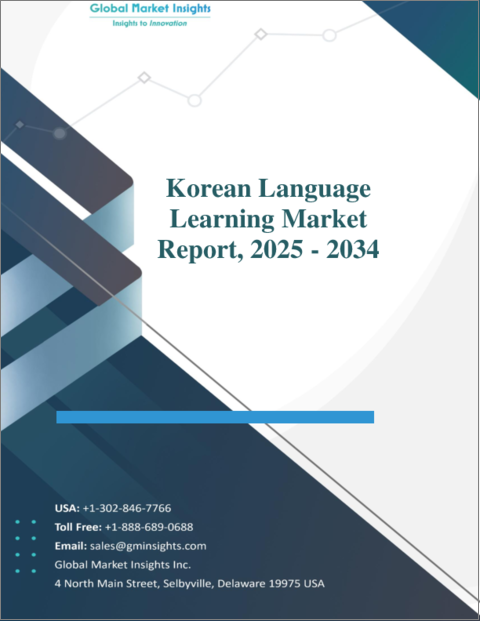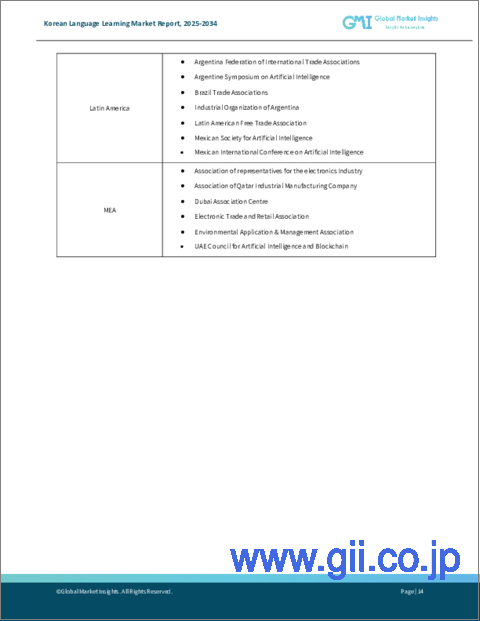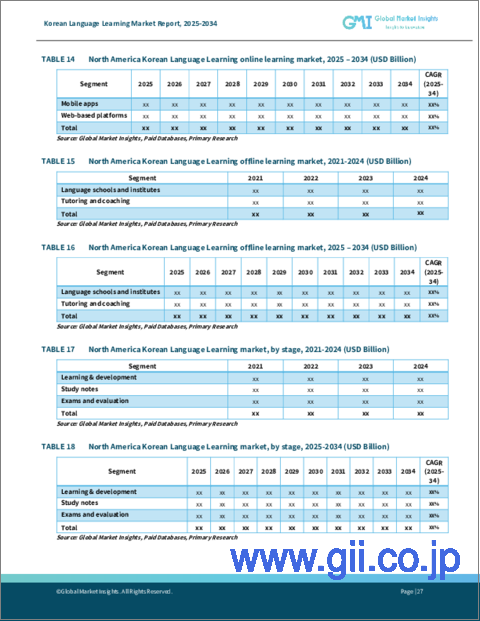|
|
市場調査レポート
商品コード
1716611
韓国語学習市場の機会、成長促進要因、産業動向分析、2025年~2034年の予測Korean Language Learning Market Opportunity, Growth Drivers, Industry Trend Analysis, and Forecast 2025 - 2034 |
||||||
カスタマイズ可能
|
|||||||
| 韓国語学習市場の機会、成長促進要因、産業動向分析、2025年~2034年の予測 |
|
出版日: 2025年03月19日
発行: Global Market Insights Inc.
ページ情報: 英文 150 Pages
納期: 2~3営業日
|
全表示
- 概要
- 目次
世界の韓国語学習市場は、2024年に72億米ドルと評価され、2025年から2034年にかけて25.1%のCAGRで堅調に成長すると予測されています。
この目覚ましい成長は主に、韓国文化への世界の憧れの高まり、経済機会の拡大、国際化の動向の高まりによるものです。韓国のエンターテインメント、特にK-POP音楽、テレビドラマ、映画が世界的に絶大な知名度を獲得するにつれ、韓国語の学習需要が急増しています。世界中のファンが韓国文化により深く触れたいと熱望しており、さまざまな学習プラットフォームで受講者が大幅に増加しています。

さらに、技術、貿易、革新における韓国の経済的地位の高まりは、特にキャリアアップを目指す専門家や学生の間で、韓国語学習への関心をさらに高めています。政府や教育機関も韓国語能力促進のメリットを認識しており、学校や大学での専用語学プログラムの導入につながっています。韓流ブームや国際市場における韓国ブランドの成功など、韓国のソフトパワーの影響力の高まりは、語学習得が文化的・経済的機会への入り口と見なされる環境を作り出しています。さらに、言語学習技術の進歩やオンライン資料の利用可能性により、世界中の学習者にとって韓国語教育がより身近で、手頃な価格で、魅力的なものとなっています。
| 市場範囲 | |
|---|---|
| 開始年 | 2024 |
| 予測年 | 2025-2034 |
| 開始金額 | 72億米ドル |
| 予測金額 | 670億米ドル |
| CAGR | 25.1% |
韓国語学習市場はさまざまな製品に区分され、2024年には合計で47億米ドルを創出しました。これらには、教科書、電子書籍、フラッシュカード、モバイルアプリケーションなどの物理的およびデジタル学習ツールが含まれます。先進技術の採用が市場に革命をもたらしており、AIを搭載したアプリ、仮想現実(VR)学習環境、ゲーム化されたプラットフォームが絶大な人気を博しています。これらの革新的なツールは、学習者が言語スキルを伸ばすためのインタラクティブで魅力的な方法を提供し、学習プロセスをよりパーソナライズされた効果的なものにしています。技術の進歩に伴い、機械学習と自然言語処理の統合が学習体験をさらに強化し、語学学習者によりよい成果をもたらしています。
同市場はまた、オンライン、オフライン、ハイブリッドモデルなど、学習形態によっても分類されます。オンライン学習が優位を占め、2034年までに164億米ドルを生み出すと予想されています。モバイル機器の普及と語学学習アプリの普及は、韓国語教育を世界中の人々が利用できるようにする上で極めて重要な役割を果たしています。自分のペースで学習できるコース、AIを活用した個別指導、インタラクティブ機能などを提供するプラットフォームは、柔軟で手頃なオプションを好む学習者を引きつけています。非同期学習モデルやバーチャルクラスルームは、学習者が自分のペースでスピーキング、リスニング、ライティングのスキルを練習する機会を提供し、多忙なライフスタイルや多様な学習嗜好に対応しています。
米国の韓国語学習市場は2034年までに66億米ドルを生み出すと予測されており、米国は韓国語学習者にとって重要な拠点となっています。特に若い世代の間で韓国ポップカルチャーの人気が高まっていることが、この需要に拍車をかけています。米国内の大学は、関心の高まりに対応するため韓国語プログラムを拡充しており、デジタル学習プラットフォームは登録者数の急増を目の当たりにしています。特にZ世代の学習者は、モバイルアプリやオンラインコースを利用して韓国語のスキルを身につけようとしており、その背景には韓国エンターテインメントへの熱狂と、韓国文化により真摯に触れたいという欲求があります。没入型・双方向型の学習プラットフォームがますます利用しやすくなることで、韓国語教育は米国内外のより多くの人々にとってより魅力的で身近なものとなりつつあります。
目次
第1章 調査手法と調査範囲
第2章 エグゼクティブサマリー
第3章 業界洞察
- エコシステム分析
- 業界への影響要因
- 促進要因
- Kカルチャーの世界的人気
- デジタル学習プラットフォームの拡大
- 政府の取り組みと支援
- ビジネスおよびキャリア機会に対する需要の高まり
- 教育カリキュラムにおける韓国語の統合
- 業界の潜在的リスク&課題
- 言語の複雑さ
- ローカライズされた学習リソースが限られている
- 促進要因
- 潜在成長力の分析
- 規制状況
- 技術情勢
- 今後の市場動向
- ギャップ分析
- ポーター分析
- PESTEL分析
第4章 競合情勢
- イントロダクション
- 企業シェア分析
- 主要市場プレーヤーの競合分析
- 競合のポジショニングマトリックス
- 戦略ダッシュボード
第5章 市場推計・予測:コンポーネント別、2021年~2034年
- 主要動向
- 製品
- サービス
第6章 市場推計・予測:学習モード別、2021年~2034年
- 主要動向
- オンライン学習
- モバイルアプリ
- ウェブベースのプラットフォーム
- オフライン学習
- 語学学校と語学教育機関
- 個別指導とコーチング
- ハイブリッド学習
第7章 市場推計・予測:媒体別、2021年~2034年
- 主要動向
- 書籍・教科書
- フラッシュカードと記憶補助教材
- モバイルアプリ
- ソフトウェア
- 学習管理システム(LMS)
- コンテンツ管理システム(CMS)
- オンライン・リソース
- オーディオ&ビデオ・リソース
- その他
第8章 市場推計・予測:ステージ別、2021年~2034年
- 主要動向
- 学習と開発
- 言語学習
- 没入型言語学習
- 学習ノート
- 試験と評価
第9章 市場推計・予測:エンドユース別、2021年~2034年
- 主要動向
- 個人
- 教育機関
- 学校・大学
- 公立学校・大学
- 私立学校・大学
- 語学教育機関
- 学校・大学
- 企業
第10章 市場推計・予測:用途別、2021年~2034年
- 主要動向
- 5~17歳
- 18~24歳
- 25~40歳
- 41歳以上
第11章 市場推計・予測:地域別、2021年~2034年
- 主要動向
- 北米
- 米国
- カナダ
- 欧州
- ドイツ
- 英国
- フランス
- スペイン
- イタリア
- オランダ
- アジア太平洋
- 中国
- インド
- 日本
- オーストラリア
- 韓国
- ラテンアメリカ
- ブラジル
- メキシコ
- アルゼンチン
- 中東・アフリカ
- サウジアラビア
- 南アフリカ
- アラブ首長国連邦
第12章 企業プロファイル
- 90 Day Korean LLC
- Duolingo
- Ewha Womans University Language Education Institute
- FluentU
- KoreanClass101
- Lingodeer Co. Ltd.
- Mango Languages
- Memrise Limited
- Pimsleur
- Rocket Languages Ltd
- Rosetta Stone LLC.
- SNU Language Education Institute(Seoul National University)
- Sogang University Korean Language Education Center
- Story learning
- Talk To Me In Korean(TTMIK)
- Verbling, Inc.
- Visang Education Inc.
- Yonsei University Korean Language Institute
The Global Korean Language Learning Market was valued at USD 7.2 billion in 2024 and is projected to grow at a robust CAGR of 25.1% between 2025 and 2034. This remarkable growth is primarily driven by the increasing global fascination with Korean culture, expanding economic opportunities, and the rising trend of internationalization. As Korean entertainment, particularly K-pop music, television dramas, and films, gains immense global recognition, the demand for learning the language has surged. Fans worldwide are eager to connect more deeply with Korean culture, driving a significant increase in enrollments across various learning platforms.

Moreover, South Korea's growing economic prominence in technology, trade, and innovation has further amplified interest in learning the language, particularly among professionals and students seeking to enhance their career prospects. Governments and educational institutions are also recognizing the benefits of promoting Korean language proficiency, leading to the introduction of dedicated language programs in schools and universities. The growing influence of Korean soft power through initiatives such as the Korean Wave (Hallyu) and the success of Korean brands in international markets has created an environment where language acquisition is seen as a gateway to cultural and economic opportunities. Additionally, advancements in language-learning technologies and the availability of online resources have made Korean language education more accessible, affordable, and engaging for learners across the globe.
| Market Scope | |
|---|---|
| Start Year | 2024 |
| Forecast Year | 2025-2034 |
| Start Value | $7.2 Billion |
| Forecast Value | $67 Billion |
| CAGR | 25.1% |
The Korean language learning market is segmented into various products that collectively generated USD 4.7 billion in 2024. These include physical and digital learning tools such as textbooks, e-books, flashcards, and mobile applications. The adoption of advanced technologies is revolutionizing the market, with AI-powered apps, virtual reality (VR) learning environments, and gamified platforms gaining immense popularity. These innovative tools provide interactive and engaging ways for learners to develop their language skills, making the learning process more personalized and effective. As technology continues to advance, the integration of machine learning and natural language processing is further enhancing the learning experience, ensuring better outcomes for language learners.
The market is also categorized by learning modes, including online, offline, and hybrid models. Online learning is expected to dominate, generating USD 16.4 billion by 2034. The proliferation of mobile devices and the widespread availability of language-learning apps have played a pivotal role in making Korean language education accessible to a global audience. Platforms offering self-paced courses, AI-driven tutoring, and interactive features are attracting learners who prefer flexible and affordable options. Asynchronous learning models and virtual classrooms provide learners with the opportunity to practice speaking, listening, and writing skills at their own pace, catering to busy lifestyles and diverse learning preferences.
The U.S. Korean language learning market is projected to generate USD 6.6 billion by 2034, establishing the United States as a significant hub for Korean language learners. The growing popularity of Korean pop culture, particularly among younger generations, has fueled this demand. Universities across the U.S. are expanding their Korean language programs to accommodate rising interest, while digital learning platforms are witnessing a surge in enrollments. Generation Z learners, in particular, are turning to mobile apps and online courses to acquire Korean language skills, driven by their enthusiasm for Korean entertainment and their desire to engage with the culture more authentically. The increasing availability of immersive and interactive learning platforms continues to make Korean language education more appealing and accessible to a wider audience in the United States and beyond.
Table of Contents
Chapter 1 Methodology and Scope
- 1.1 Market scope and definitions
- 1.2 Research design
- 1.2.1 Research approach
- 1.2.2 Data collection methods
- 1.3 Base estimates and calculations
- 1.3.1 Base year calculation
- 1.3.2 Key trends for market estimation
- 1.4 Forecast model
- 1.5 Primary research and validation
- 1.5.1 Primary sources
- 1.5.2 Data mining sources
Chapter 2 Executive Summary
- 2.1 Industry 3600 synopsis
Chapter 3 Industry Insights
- 3.1 Industry ecosystem analysis
- 3.2 Industry impact forces
- 3.2.1 Growth drivers
- 3.2.1.1 Global Popularity of K-Culture
- 3.2.1.2 Expansion of digital learning platforms
- 3.2.1.3 Government initiatives and support
- 3.2.1.4 Rising demand for business and career opportunities
- 3.2.1.5 Integration of korean in academic curricula
- 3.2.2 Industry pitfalls and challenges
- 3.2.2.1 Complexity of the language
- 3.2.2.2 Limited localized learning resources
- 3.2.1 Growth drivers
- 3.3 Growth potential analysis
- 3.4 Regulatory landscape
- 3.5 Technology landscape
- 3.6 Future market trends
- 3.7 Gap analysis
- 3.8 Porter's analysis
- 3.9 PESTEL analysis
Chapter 4 Competitive Landscape, 2024
- 4.1 Introduction
- 4.2 Company market share analysis
- 4.3 Competitive analysis of major market players
- 4.4 Competitive positioning matrix
- 4.5 Strategy dashboard
Chapter 5 Market Estimates and Forecast, By Component, 2021 – 2034 (USD Mn)
- 5.1 Key trends
- 5.2 Product
- 5.3 Services
Chapter 6 Market Estimates and Forecast, By Learning Mode, 2021 – 2034 (USD Mn)
- 6.1 Key trends
- 6.2 Online Learning
- 6.2.1 Mobile apps
- 6.2.2 Web-based platform
- 6.3 Offline learning
- 6.3.1 Language schools and institute
- 6.3.2 Tutoring and coaching
- 6.4 Hybrid learning
Chapter 7 Market Estimates and Forecast, By Medium, 2021 – 2034 (USD Mn)
- 7.1 Key trends
- 7.2 Books and textbooks
- 7.3 Flashcards and memory aids
- 7.4 Mobile apps
- 7.5 Software
- 7.5.1 Learning Management Systems (LMS)
- 7.5.2 Content Management Systems (CMS)
- 7.6 Online resources
- 7.7 Audio & video resources
- 7.8 Others
Chapter 8 Market Estimates and Forecast, By Stage, 2021 – 2034 (USD Mn & Units)
- 8.1 Key trends
- 8.2 Learning & development
- 8.2.1 Language learning
- 8.2.2 Immersive language learning.
- 8.3 Study notes
- 8.4 Exams and evaluation
Chapter 9 Market Estimates and Forecast, By End Use, 2021 – 2034 (USD Mn)
- 9.1 Key trends
- 9.2 Individual
- 9.3 Educational institutes
- 9.3.1 Schools and universities
- 9.3.1.1 Public schools & universities
- 9.3.1.2 Private schools & universities
- 9.3.2 Language institutes
- 9.3.1 Schools and universities
- 9.4 Corporate
Chapter 10 Market Estimates and Forecast, By Application, 2021 – 2034 (USD Mn)
- 10.1 Key trends
- 10.2 Age 5-17
- 10.3 Ages 18-24
- 10.4 Ages 25-40
- 10.5 Ages 41 and above
Chapter 11 Market Estimates and Forecast, By Region, 2021 – 2034 (USD Mn)
- 11.1 Key trends
- 11.2 North America
- 11.2.1 U.S.
- 11.2.2 Canada
- 11.3 Europe
- 11.3.1 Germany
- 11.3.2 UK
- 11.3.3 France
- 11.3.4 Spain
- 11.3.5 Italy
- 11.3.6 Netherlands
- 11.4 Asia Pacific
- 11.4.1 China
- 11.4.2 India
- 11.4.3 Japan
- 11.4.4 Australia
- 11.4.5 South Korea
- 11.5 Latin America
- 11.5.1 Brazil
- 11.5.2 Mexico
- 11.5.3 Argentina
- 11.6 Middle East and Africa
- 11.6.1 Saudi Arabia
- 11.6.2 South Africa
- 11.6.3 UAE
Chapter 12 Company Profiles
- 12.1 90 Day Korean LLC
- 12.2 Duolingo
- 12.3 Ewha Womans University Language Education Institute
- 12.4 FluentU
- 12.5 KoreanClass101
- 12.6 Lingodeer Co. Ltd.
- 12.7 Mango Languages
- 12.8 Memrise Limited
- 12.9 Pimsleur
- 12.10 Rocket Languages Ltd
- 12.11 Rosetta Stone LLC.
- 12.12 SNU Language Education Institute (Seoul National University)
- 12.13 Sogang University Korean Language Education Center
- 12.14 Story learning
- 12.15 Talk To Me In Korean (TTMIK)
- 12.16 Verbling, Inc.
- 12.17 Visang Education Inc.
- 12.18 Yonsei University Korean Language Institute






